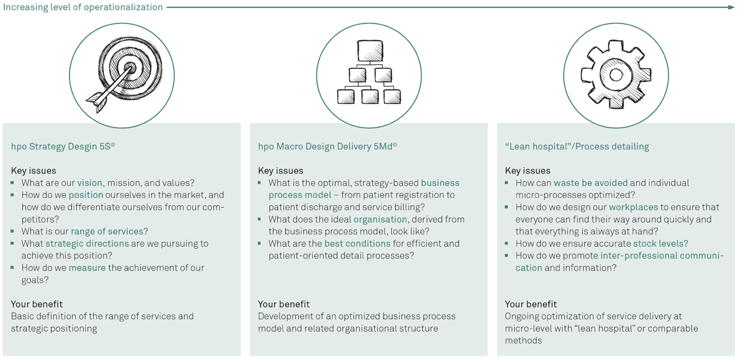hpo Spotlight
Lean hospital – a cure-all?
The Swiss healthcare system is facing major challenges. “Lean hospital” was long considered a cure-all, but it did not bring the desired success in many cases. The reason is simple: While “lean hospital” optimizes detailed processes, it does not address the fundamental design flaws for a patient-centered healthcare system. Here is where a process model derived from the strategy comes in handy. Learn more with these hpo Insights.
Share article

Create preconditions
Increasing quality and decreasing costs
Everyone agrees on one point: the Swiss health system is facing major challenges. Increasing cost pressure, a shortage of skilled workers and the growing expectations of patients are just a few of the issues that cause many a hospital director sleepless nights.
"Lean Hospital" attempts to meet these challenges. With numerous methods and instruments, it aims to optimise the process flow by avoiding waste, such as unnecessarily high administrative expenses or long waiting times.
Costs should decrease, quality and thus patient and staff satisfaction increase. This sounds comprehensible and thoroughly attractive. But as is so often the case, appearances are deceptive.
Not losing sight of the big picture
In recent years, more and more Swiss hospitals have jumped on the Lean Hospital bandwagon. However, the reports on their experiences are not all positive. In fact, Lean Hospital has already spoiled things for some hospitals.
Why is that? The answer is simple: the big levers for improvement lie in the correct linking of the many activities that are necessary for the well-being of the patient. If this prerequisite is met, the advantages of Lean Hospital also come into play.
The effective design of services in care therefore needs:
- an understandable and forward-looking strategy,
- a process-oriented organisation with clear tasks, competencies and responsibilities
- and - not to be underestimated - a culture that supports the strategy.
Efficiency is only half the battle
When measures do not work
Imagine that a certain process keeps giving you a stomachache. So you take pen and paper and draw a flow chart of the process. In the process, you uncover weak points in discussion with your colleagues, develop and test optimisation possibilities and take appropriate measures. These are implemented - but somehow no noticeable effect occurs.
The problem with looking at individual micro-processes is that sometimes the devil is not in the detail, but in the associated superstructure (see example below). If the superstructure has significant weaknesses, the micro-level work is of little use except for sweat and costs.
hpo example: warehouse optimisation
An industrial company wanted to optimise a warehouse in order to be able to supply customers faster and more reliably with better processes.
Based on the hpo methodology Macro Design Delivery 5Md©, we analysed the company's service offering with a more holistic perspective. In the process, we came to the astonishing realisation: by redesigning the value chain, the warehouse became superfluous!
Instead of optimising the processes within the warehouse with Lean, we "abolished" the warehouse without further ado. If we had only focused on the processes within the warehouse, the customer would have an optimised but superfluous warehouse today.
Business process model as a basis
In our understanding, the "superstructure" of the micro level is the business process model. This is derived from the services defined in the strategy and represents the entire value creation of a company, i.e. from marketing to procurement and production (or provision of a service) to delivery and billing.
Just like Lean Hospital, the hpo methodology Macro Design Delivery 5Md© has its origins in industry. In numerous projects, we have established and proven that the systematic derivation of the business process model also provides great added value for companies in other sectors.
Benefit for your health institution
The immediate application that emerges from the business process model of a hospital, psychiatry or other health institution is the derivation of the process-based organisation. Based on the model, we can see which competences are needed for which work step and how the individual processes interlock.
A process-based organisation fulfils two essential criteria of a high-performance organisation: patient orientation and end-to-end responsibility. The process model at the macro level is also the basis for the management of hospitals with several locations and the development of promising cooperation models.
Central questions are:
- What services do we want to provide and where?
- How do we ensure that continuity of treatment is guaranteed for the patient?
- What know-how is required at which locations?
- How can it be made available for the treatment of all patients?
Last but not least, the development of the business process model and the associated organisation also promotes the willingness of the staff to change. During the development process, we always involve the key people from different hierarchical levels and areas on the client side. If they can help shape their own future, they are usually also interested in convincing the other stakeholders of the new solution - and in implementing it.
Lean Hospital - a cure-all?
Lean is not a cure-all, despite its proven qualities. A consistent business process model and the organisation derived from it are the basis for a patient-centred and effective organisation. Only on this basis can Lean Hospital and comparable methods contribute to further deepening the idea of efficiency.
A process-based organisation fulfils two essential criteria of a high-performance organisation: patient orientation and end-to-end responsibility.

Successful Symbiosis

Your strategy and organisation consultancy
Who is hpo management consulting?
hpo stands for High Performance Organisations. As experts for strategy, business processes, organisation and transformation, we have been supporting nationally and globally active clients since 1995 in releasing performance potential and transforming strategies into measurable results. With our holistic and partnership-based enterprise desing approach, we reliably lead them to their goal: a consistently designed and sustainably effective High Performance Organisation - fit for the future and with a clear competitive advantage.
hpo - unlocking performance